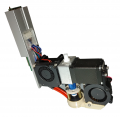Difference between revisions of "Filament Heads"
Jump to navigation
Jump to search
| Line 86: | Line 86: | ||
|- | |- | ||
|} | |} | ||
==Research Papers Citing Hyrel Hot Flow== | |||
* [http://hyrel3d.net/papers/Fully_3D-Printed_RF_Structures.pdf Demonstration and Characterization of Fully 3D-printed RF Structures], [http://www.ieee.org/index.html The Institute of Electrical and Electronics Engineers, Incorporated (IEEE)] | |||
* [http://hyrel3d.net/papers/NinjaFlex_Filament_for_Antenna_Applications.pdf Infill Dependent 3D-Printed Material Based on NinjaFlex Filament for Antenna Applications], [http://www.ieee.org/index.html The Institute of Electrical and Electronics Engineers, Incorporated (IEEE)] | |||
* [http://hyrel3d.net/papers/Novel_Strain_Sensor_Based_on_3D_Printing.pdf A Novel Strain Sensor Based on 3D Printing Technology and 3D Antenna Design], [http://www.ieee.org/index.html The Institute of Electrical and Electronics Engineers, Incorporated (IEEE)] | |||
* [http://hyrel3d.net/papers/3D_Printed_Loop_Antenna_for_Wearable_and_IoT_Applications.pdf A Novel 3-D Printed Loop Antenna Using Flexible NinjaFlex Material for Wearable and IoT Applications], [http://www.ieee.org/index.html The Institute of Electrical and Electronics Engineers, Incorporated (IEEE)] | |||
* [http://hyrel3d.net/papers/RF_Characterization_of...NinjaFlex.pdf RF Characterization of 3D Printed Flexible Materials - NinjaFlex Filaments], [http://www.eumwa.org/en/euma/ The European Microwave Association (EuMA)] | |||
*[http://hyrel3d.net/papers/Nano-Material_Based_Flexible_RF_Sensors.pdf Nano-Material Based Flexible Radio Frequency Sensors for Wearable Health and Environment Monitoring: Designs and Prototypes Utilizing 3D/Inkjet Printing Technologies], A Dissertation Presented to The Academic Faculty of [https://www.ece.gatech.edu/ The School of Electrical and Computer Engineering at Georgia Tech] | |||
Revision as of 12:37, 29 August 2016
Hot Flow is our term for filament-based materials which are deposited at over 150°C, depending on the head.
Note that at present, our Hot Flow heads work with 1.75mm filament (actually, 1.6mm to 1.9mm), but not 3mm filament.
Materials for Hot Flow
The following materials can be printed from Hot Flow heads.
- ABS (Acrylonitrile Butadiene Styrene)
- Flame Retardant ABS
- ABS - PC Alloy
- Conductive ABS
- Smart ABS
- BendLay
- Flex 45
- HIPS (High-Impact PolyStyrene)
- LayBrick
- LayWoo-d3
- MoldLay
- Ninjaflex
- Nylon
- Taulman 618, 645, 910
- PC (PolyCarbnoate)
- PEEK (PolyEther Ether Ketone)
- PET (PolyEthylene Terephthalate)
- PETG PolyEthylene Terephthalate Glycol-modified)
- PLA (Polylactic acid)
- EcoFlex PLA
- Conductive PLA
- SS PLA (Stainless Steel infused)
- PlastInk_Rubber
- PP (PolyPropylene)
- PVA (PolyVinyl Alcohol)
- T-Glase
Heads for Hot Flow
Hot Flow is available through the following heads:
The following table compares the properties of the various Hot Flow heads, including which heads are recommended for which materials. The MK1 heads drive matieral from one side, with a spring-loaded bearing system to maintain pressure and positioning. The MK2 heads drive the material from both sides, and are designed for more flexible filaments.
| Head | Min Temp | Max Temp | Filament Type | Nozzle | Recommended For |
|---|---|---|---|---|---|
| MK1-250 | 150°C | 250°C | Standard | .35mm, .50mm, .75mm, 1.0mm | ABS, LayBrick, LayWood, Nylon, PET, PETG, PETT, PLA, PP, PVA, T-Glase |
| MK2-250 | 150°C | 250°C | Flexible | .35mm, .50mm, .75mm, 1.0mm | BendLay, FilaFlex, Flex45, NinjaFlex, PlastInk Rubber |
| MK1-450 | 250°C | 450°C | Engineering | .50mm | PC, PEEK |
Research Papers Citing Hyrel Hot Flow
- Demonstration and Characterization of Fully 3D-printed RF Structures, The Institute of Electrical and Electronics Engineers, Incorporated (IEEE)
- Infill Dependent 3D-Printed Material Based on NinjaFlex Filament for Antenna Applications, The Institute of Electrical and Electronics Engineers, Incorporated (IEEE)
- A Novel Strain Sensor Based on 3D Printing Technology and 3D Antenna Design, The Institute of Electrical and Electronics Engineers, Incorporated (IEEE)
- A Novel 3-D Printed Loop Antenna Using Flexible NinjaFlex Material for Wearable and IoT Applications, The Institute of Electrical and Electronics Engineers, Incorporated (IEEE)
- RF Characterization of 3D Printed Flexible Materials - NinjaFlex Filaments, The European Microwave Association (EuMA)
- Nano-Material Based Flexible Radio Frequency Sensors for Wearable Health and Environment Monitoring: Designs and Prototypes Utilizing 3D/Inkjet Printing Technologies, A Dissertation Presented to The Academic Faculty of The School of Electrical and Computer Engineering at Georgia Tech


